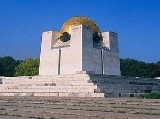
Pantheon of National Revival Heroes
Encyclopedia
The Pantheon of National Revival Heroes is a Bulgaria
n national monument and an ossuary
, located in the city of Rousse
. 39 famous Bulgarians are buried in it, including Lyuben Karavelov
, Zahari Stoyanov
, Stefan Karadzha
, Panayot Hitov
, Tonka Obretenova
, Nikola Obretenov
, Panayot Volov
, Angel Kanchev
, etc.; 453 more people—participants in Botev's detachment, the Chervena Voda detachment, in the April uprising
, and other revolutionaries have been honoured by writing their names in the interior. An eternal fire burns in the middle under the gold-plated dome
. The Pantheon is one of the 100 Tourist Sites of Bulgaria
.
In order to build the Pantheon in 1977, the "All Saints" church in the old Rousse cemetery was demolished. The new building was open for visitors on 28 February 1978. After a public discussion in 2001, the Patheon was "Christianised" by placing a cross on top of its dome. The "St Paisius of Hilendar" chapel, as well as a museum exposition, were founded then.
Bulgaria
Bulgaria , officially the Republic of Bulgaria , is a parliamentary democracy within a unitary constitutional republic in Southeast Europe. The country borders Romania to the north, Serbia and Macedonia to the west, Greece and Turkey to the south, as well as the Black Sea to the east...
n national monument and an ossuary
Ossuary
An ossuary is a chest, building, well, or site made to serve as the final resting place of human skeletal remains. They are frequently used where burial space is scarce. A body is first buried in a temporary grave, then after some years the skeletal remains are removed and placed in an ossuary...
, located in the city of Rousse
Rousse
Ruse is the fifth-largest city in Bulgaria. Ruse is situated in the northeastern part of the country, on the right bank of the Danube, opposite the Romanian city of Giurgiu, from the capital Sofia and from the Bulgarian Black Sea Coast...
. 39 famous Bulgarians are buried in it, including Lyuben Karavelov
Lyuben Karavelov
Lyuben Stoychev Karavelov was a Bulgarian writer and an important figure of the Bulgarian National Revival....
, Zahari Stoyanov
Zahari Stoyanov
Zahari Stoyanov , born Dzhendo Stoyanov Dzhedev , was a Bulgarian revolutionary, writer, and historian. A participant in the April Uprising of 1876, he became its first historiographer with his book Memoirs of the Bulgarian Uprisings...
, Stefan Karadzha
Stefan Karadzha
Stefan Karadzha , was a Bulgarian national hero, a revolutionary from the national liberation movement and a prominent leader of rebellion against the Ottoman Empire....
, Panayot Hitov
Panayot Hitov
Panayot Ivanov Hitov was a Bulgarian hajduk, national revolutionary and band leader .Born in 1830 in Sliven, he became a hajduk in Georgi Trankin's band in 1858. Two years later, after the death of Trankin, Hitov succeeded him as voivode of the band, which became one of the most active in...
, Tonka Obretenova
Tonka Obretenova
Tonka Obretenova , known as baba Tonka , was a female Bulgarian revolutionary, born in 1812, probably in Rousse.Her parents, Toncho Postavchiyata and Minka Toncheva , were from the village of Cherven. She married Tiho Obretenov — a famous tailor and tradesman in Rousse...
, Nikola Obretenov
Nikola Obretenov
Nikola Tihov Obretenov was a Bulgarian revolutionary, one of the combatants for the liberation of Bulgaria, and a participant in the Stara Zagora Uprising and the April Uprising...
, Panayot Volov
Panayot Volov
Panayot Volov was the pseudonym of Petar Vankov , the organizer and leader of the Gyurgevo Revolutionary Committee of the Bulgarian April Uprising against the Ottoman Empire in 1876....
, Angel Kanchev
Angel Kanchev
Angel Kanchev Angelov was a Bulgarian revolutionary from Tryavna.Kanchev was born in 1852 in the family of a master-builder. At first he studied in his hometown Tryavna and then in Ruse under the guidance of people like Pencho Slaveykov and Dragan Tsankov...
, etc.; 453 more people—participants in Botev's detachment, the Chervena Voda detachment, in the April uprising
April Uprising
The April Uprising was an insurrection organised by the Bulgarians in the Ottoman Empire from April to May 1876, which indirectly resulted in the re-establishment of Bulgaria as an autonomous nation in 1878...
, and other revolutionaries have been honoured by writing their names in the interior. An eternal fire burns in the middle under the gold-plated dome
Dome
A dome is a structural element of architecture that resembles the hollow upper half of a sphere. Dome structures made of various materials have a long architectural lineage extending into prehistory....
. The Pantheon is one of the 100 Tourist Sites of Bulgaria
100 Tourist Sites of Bulgaria
"100 Tourist Sites of Bulgaria" is a Bulgarian national movement established in 1966 to promote tourism among Bulgaria's most significant cultural, historic, and natural landmarks....
.
In order to build the Pantheon in 1977, the "All Saints" church in the old Rousse cemetery was demolished. The new building was open for visitors on 28 February 1978. After a public discussion in 2001, the Patheon was "Christianised" by placing a cross on top of its dome. The "St Paisius of Hilendar" chapel, as well as a museum exposition, were founded then.

